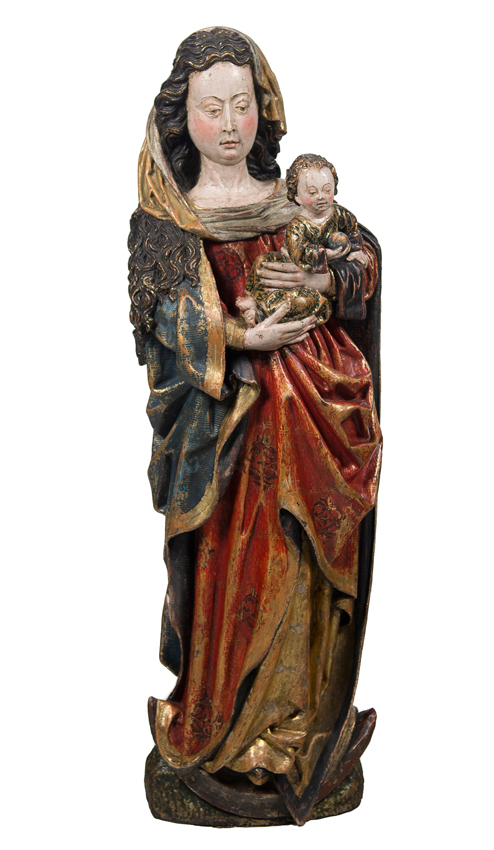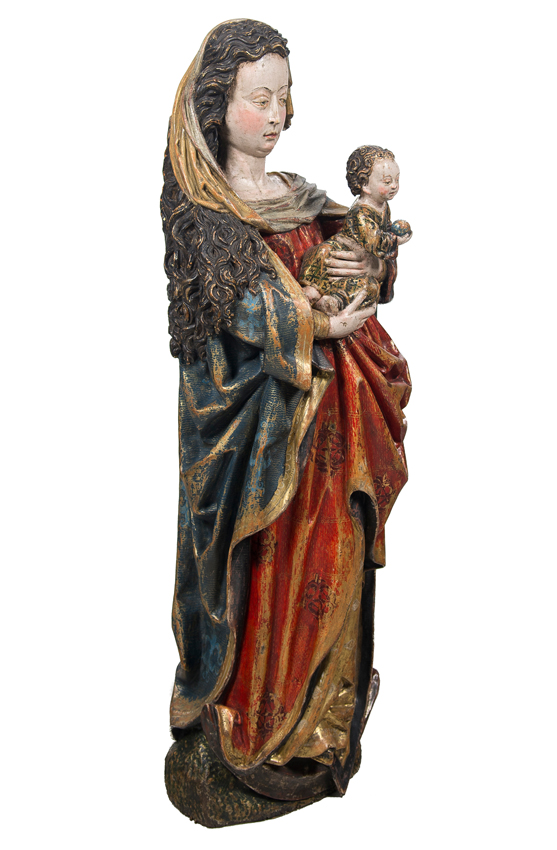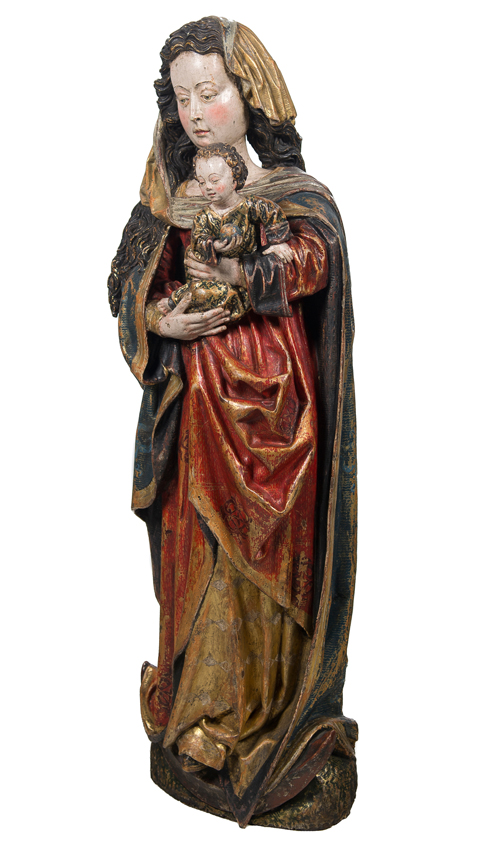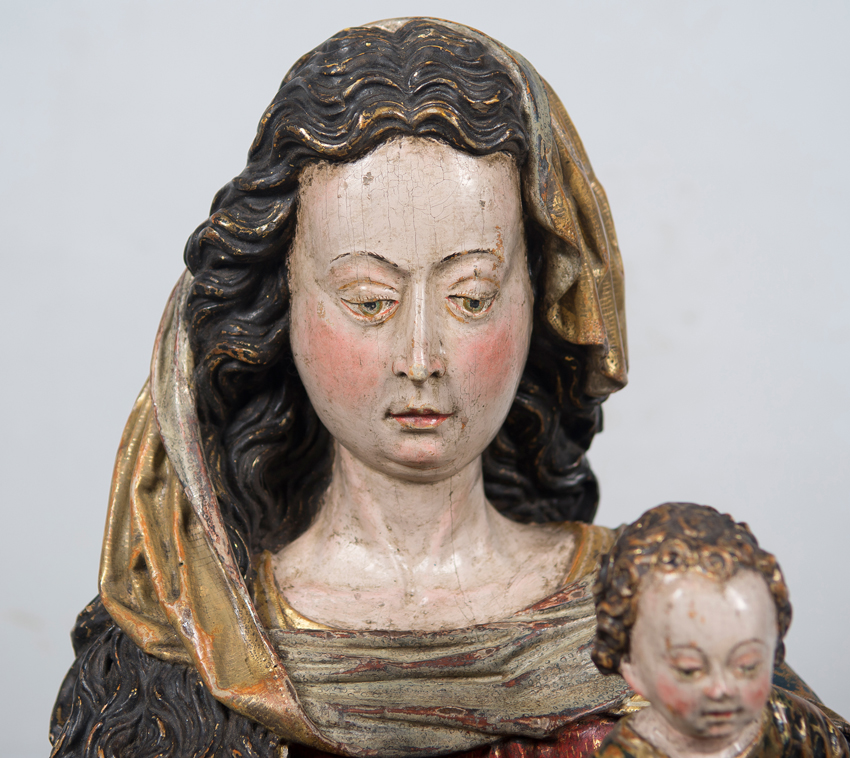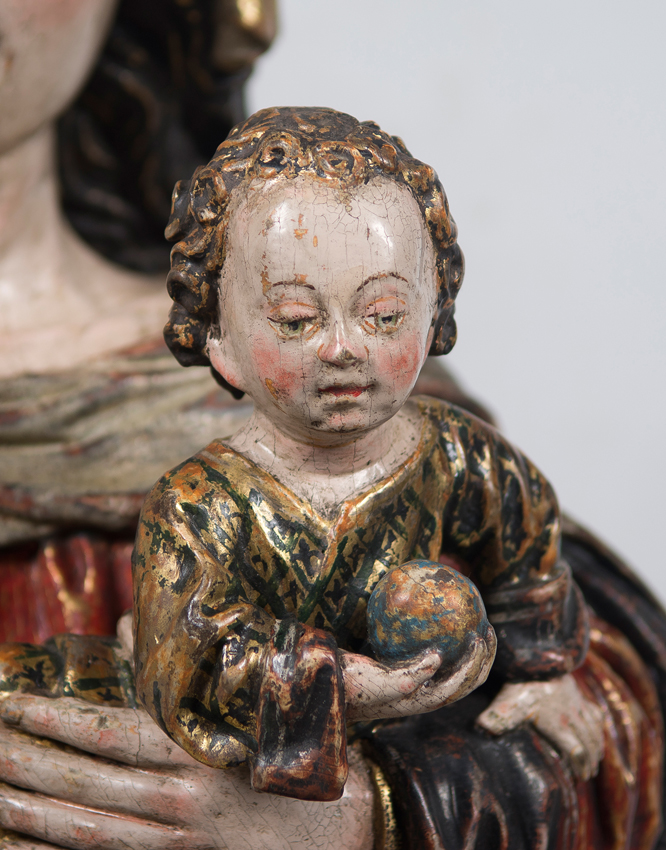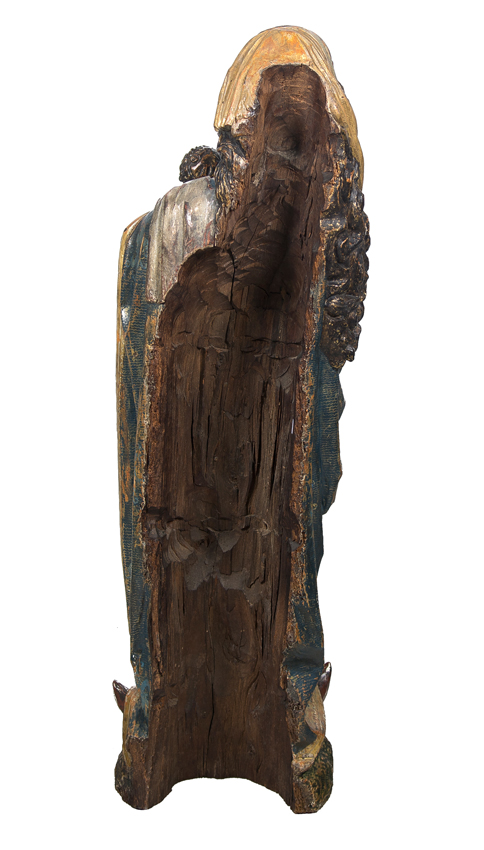4
Hispano Flemish School. Late15th century.
Hispano Flemish School. Late15th century.
"Madonna and Child"
Carved, gilded and polychrome wooden sculpture.
105 x 35 x 30 cm.
This Virgin and Child is a delicate and exquisite late Gothic piece that perpetuates the typical medieval iconography of the Virgin standing with the Child Jesus in her arms, although with an accentuated human quality that is characteristic of late Gothic imagery. Also, in accordance with the aesthetic ideas of this time, the garments worn by the Virgin are a faithful reflection of those used by the ladies of the time. The sculpture was, without a doubt, conceived as an altarpiece image since the back is not only not carved or polychromed but is directly hollowed out. What is more difficult to gauge is the position it would have occupied in the altarpiece, although if we take the iconography and the very high quality of the piece into account, there is a possibility that it was the central image of the altarpiece.
As mentioned previously, the Virgin Mary is standing erect, she is on a crescent moon with upward pointing ends, which alludes to her Immaculate Conception, that is to say, Mary was born without the stain of original sin. Although the body has a certain rigidity, this at the same time endows it with dignity and majesty. She directs her gaze to the front, instead of her Son, with whom she does not maintain visual contact, but physical contact, given that she holds him lovingly with both hands: with the right she grasps him and with the left she gathers him against her breast. The Virgin wears a wide white tunic, from which the tip of one of her shoes sticks out from the lower part, a red over-tunic with a rounded neckline and decorated with some floral-geometric motifs, a blue mantle with light but continuous golden linear motifs and a narrow golden border that runs along the entire garment, and a veil that partially covers her hair. The veil covers both shoulders at the front, then ascends along the right side of the hair and behind it until it hangs on the left side of the head. The hard, heavy, broken folds are sculpted with deep grooves that form rigidly geometric outlines, and are typical of the Hispano-Flemish school.
The head, almost oval in shape, is very elongated which means it has a very wide, clear forehead. The half-open eyes are slanted and have drooping eyelids, the nose is elongated, very thin, and has carved nostrils giving it a greater sense of naturalism. A nasolabial furrow has been carved, while the mouth has small closed lips that are closed tight in such a way that small holes are formed in the corners. In the lower part of the face we see broad pink cheekbones, a powerful chin and a slight double chin. She has abundant hair, in which traces of gold hairs can be seen, composed of large moving masses distributed more or less symmetrically, the locks located on both sides of the face acquire remarkable volume and definition, indicating that the sculptor must have used a trephine.
The somewhat self-absorbed attitude of the Mother is contrasted with the carefree attitude of the Son, who is in her hands, turning his face to look directly at the worshippers. In a dynamic attitude, he tries to stand up, without succeeding, resting his right hand on his mother's sleeve, while in his left hand he carries a polychrome orb as if it were the Earth, with the continents, islands and the great seas and oceans that make it up. The orb, one of the most characteristic attributes of the Christ Child, whether alone or accompanying his mother, symbolizes the authority and moral dominion of Christ over the universe. The Child's legs are open, between which there is room for his mother's hand, and his feet are joined in parallel. The face, which has a more rounded format, has facial features similar to Mary's, although the hair is flat with curly ringlets. He wears a wide golden tunic with geometric motifs (rhombuses and blades) painted in green that only covers the neck, hands and feet.
This exquisite carving must be ascribed to the Hispano-Flemish current and more specifically to the gouges of an outstanding anonymous master installed somewhere in Castile, Spain. It is clear that the artist was a foreign sculptor originally from Northern Europe, because of the attachment to the models and styles of the sculpture from those lands, suggested by the oval conception of the head, the sharp nose and the straight mouth with thin lips. There are also certain similarities in the way the folds of the clothing is treated based on broken, geometric draperies and with deep hollows.
We would like to thank Dr. Javier Baladrón, doctor in Art History, for the identification and cataloguing of this sculpture.
Hispano Flemish School. Late15th century.
"Madonna and Child"
Carved, gilded and polychrome wooden sculpture.
105 x 35 x 30 cm.
This Virgin and Child is a delicate and exquisite late Gothic piece that perpetuates the typical medieval iconography of the Virgin standing with the Child Jesus in her arms, although with an accentuated human quality that is characteristic of late Gothic imagery. Also, in accordance with the aesthetic ideas of this time, the garments worn by the Virgin are a faithful reflection of those used by the ladies of the time. The sculpture was, without a doubt, conceived as an altarpiece image since the back is not only not carved or polychromed but is directly hollowed out. What is more difficult to gauge is the position it would have occupied in the altarpiece, although if we take the iconography and the very high quality of the piece into account, there is a possibility that it was the central image of the altarpiece.
As mentioned previously, the Virgin Mary is standing erect, she is on a crescent moon with upward pointing ends, which alludes to her Immaculate Conception, that is to say, Mary was born without the stain of original sin. Although the body has a certain rigidity, this at the same time endows it with dignity and majesty. She directs her gaze to the front, instead of her Son, with whom she does not maintain visual contact, but physical contact, given that she holds him lovingly with both hands: with the right she grasps him and with the left she gathers him against her breast. The Virgin wears a wide white tunic, from which the tip of one of her shoes sticks out from the lower part, a red over-tunic with a rounded neckline and decorated with some floral-geometric motifs, a blue mantle with light but continuous golden linear motifs and a narrow golden border that runs along the entire garment, and a veil that partially covers her hair. The veil covers both shoulders at the front, then ascends along the right side of the hair and behind it until it hangs on the left side of the head. The hard, heavy, broken folds are sculpted with deep grooves that form rigidly geometric outlines, and are typical of the Hispano-Flemish school.
The head, almost oval in shape, is very elongated which means it has a very wide, clear forehead. The half-open eyes are slanted and have drooping eyelids, the nose is elongated, very thin, and has carved nostrils giving it a greater sense of naturalism. A nasolabial furrow has been carved, while the mouth has small closed lips that are closed tight in such a way that small holes are formed in the corners. In the lower part of the face we see broad pink cheekbones, a powerful chin and a slight double chin. She has abundant hair, in which traces of gold hairs can be seen, composed of large moving masses distributed more or less symmetrically, the locks located on both sides of the face acquire remarkable volume and definition, indicating that the sculptor must have used a trephine.
The somewhat self-absorbed attitude of the Mother is contrasted with the carefree attitude of the Son, who is in her hands, turning his face to look directly at the worshippers. In a dynamic attitude, he tries to stand up, without succeeding, resting his right hand on his mother's sleeve, while in his left hand he carries a polychrome orb as if it were the Earth, with the continents, islands and the great seas and oceans that make it up. The orb, one of the most characteristic attributes of the Christ Child, whether alone or accompanying his mother, symbolizes the authority and moral dominion of Christ over the universe. The Child's legs are open, between which there is room for his mother's hand, and his feet are joined in parallel. The face, which has a more rounded format, has facial features similar to Mary's, although the hair is flat with curly ringlets. He wears a wide golden tunic with geometric motifs (rhombuses and blades) painted in green that only covers the neck, hands and feet.
This exquisite carving must be ascribed to the Hispano-Flemish current and more specifically to the gouges of an outstanding anonymous master installed somewhere in Castile, Spain. It is clear that the artist was a foreign sculptor originally from Northern Europe, because of the attachment to the models and styles of the sculpture from those lands, suggested by the oval conception of the head, the sharp nose and the straight mouth with thin lips. There are also certain similarities in the way the folds of the clothing is treated based on broken, geometric draperies and with deep hollows.
We would like to thank Dr. Javier Baladrón, doctor in Art History, for the identification and cataloguing of this sculpture.
From East to West. A merging of artistic influences
Sale Date(s)
Venue Address
General delivery information available from the auctioneer
The purchase price includes the delivery of the lots in the venue of the auction. Transporting to other destinations is at the own risk of the client. The customer must contact "LST", to give the corresponding instructions for such transporting. "LST" is not responsible for the packaging or any accident incurred during transportation.
Important Information
Terms & Conditions
CONDITIONS OF THE AUCTION:
I. REGISTRATION. To bid in the room customers must register at the beginning, filling out a form and picking a number that will identify them during the auction. Customers may be required to register in bank references or other guarantee system and if they do not prove the solvency "LST" will not accept bids and award the auction.
II. WRITTEN BIDS. "LST" will accept written bids, which will be formalized in the form provided by the room until the day before the auction. In such auctions, the room will bid in name of the client until the maximum stated in the offer and always at the lowest possible price. If there are two or more bids for the same amount, the one placed first will have the priority. Written bids received in advance, will have priority on the day of the auction.
III. TELEPHONE BIDS. "LST" will allow telephone bids, if interested people contact "LST" days before the auction providing personal data, ID card and the phone number which will be used by the staff of "LST" to call at the time of the auction. The buyer, within all the legal rights is making an offer for the asking price, when applies for telephone bid. "LST" will not take responsibility for any technical defects beyond its control, which may prevent to contact successfully the bidder during the auction.
IV. AUCTIONEER. The auction will be conducted by an auctioneer, director of the auction will be judge and arbitrator of it with full authority in its development, will award the lots to the highest bidder and is able to settle any controversy concerning lots sale, reject bids, divide lots or group them and remover objects from the room. Will be able to, if it is deemed suitable, not accept bids on the auction. His decision will be unappealable.
V. SALE OF LOTS. The lots are awarded to the highest bidder. Once the auctioneer blows the hammer, the buyer becomes responsible of the lot purchased, exempting "LST" of liability to for any damage and / or accidents that may occur. No refunds of lots.
VI. STARTING PRICE. The amount shown in the catalogue as the starting price for each lot will be, as a rule, the minimum selling price, except for exceptional cases where a reservation may be agreed upon with the seller or it set discretionary by the room.
VII. SCALE OF BIDS. The bids are set according to the following scale:
From 50.-€ to 200.-€…………………………………………..at 10.-€
From 200.-€ to 500.-€…………………………………… …25 in 25.-€
From 500.-€ to 1.000.-€………………………………..…..….50 in 50.-€
From 1.000.-€ to 2.000.-€………………………………..…100 in 100.-€
From 2.000.-€ to 5.000.-€……………………………….….250 in 250.-€
From 5.000.-€ to 10.000.-€…………………………………500 in 500.-€
From 10.000.-€ to 20.000.-€……………………………1.000 in 1.000.-€
From 20.000.-€ to 50.000.-€……………………………2.500 in 2.500.-€
From 50.000.-€ to 100.000.-€…………………………..5.000 in 5.000.-€
From 100.000.-€ to 100.000.-€………………………10.000 in 10.000.-€
From 200.000.-€ to 200.000.-€………………………25.000 in 25.000.-€
From 500.000.-€ to 500.000.-€………………………50.000 in 50.000.-€
VIII. RIGHT OF ADMISION. "LST" reserves the right to admission to the auction room and to reject, at its judgment, any purchase order, from clients whose solvency is not duly proved as well as not to sale auctions.
IX. SALE PRICES. The successful bidder of one or more lots must pay "LST" the final sale price achieves at auction, plus the 24,5 % plus 21% VAT on the commission, at total 29,64 % on Hammer Price.
X. CATALOG DATA. The catalogue data are obtained in order to careful research and advice, however, any responsibility is afforded about its accuracy. The lots will be auctioned in the state in which they are, not accepting any claims in restorations, breakage, damage, imperfections and, even description or numbering mistakes in the catalogue, in case of it, being the burden of the buyers to make sure before the auction that the description matches with their personal opinion about respective lot. The exhibition of the lots is intended to allow a perfect review and study of them.
XI. PAYMENT AND REMOVAL OF LOTS. Payment and removal of the lots will be held no later than five days following the auction. After this period expire without having the buyer removed the lot or lots purchases, it will accrue an expense of custody of 6 euros per day on each lot.
15 days after the auction without having the buyer paid and removes the sold lots, "LST" will inform the seller and there will begin judicial proceeding in order to obtain payment. The delay in payment by the purchaser of his/her sold lots will carry an interest increase at a rate of 1,5% per month.
XII. DELIVERY OF LOTS. The purchase price includes the delivery of the lots in the venue of the auction. Transporting to other destinations is at the own risk of the client. The customer must contact "LST", to give the corresponding instructions for such transporting. "LST" is not responsible for the packaging or any accident incurred during transportation.
XIII. RIGHT OF FIRT REFUSAL AND REPURCHASE. "LST" in order to article 38 of "Ley 16/1985 de 25 Junio del Patrimonio Histórico Español" (BOE. 155 June 29, 1985), will notify in advance to the Ministry of Culture, the content of their catalogues. Concerning the lots subject to the legislation referred to in the preceding paragraph, the Administration may exercise the rights of first refusal and repurchase according to the law. "LST" will watch over the protection of Artistic, Historical and Bibliographical Heritage of Spain. For customers out of European Community, a tax for export is required by the Administration.
XIV. VALUE ADDED TAX (I.V.A). This tax will be accrued on commissions of "LST" for buyers, using the rates prevailing on the date of the auction.
XV. DATA PROTECTION. In order to the "Ley 15/1999 de 13 de Diciembre, de Protección de Datos de Carácter Personal", the client authorize "LST", the inclusion of their data in a customer file, and for the promotion by "LST" of the objects at all times the rights of access, rectification or deletion of personal data by sending the appropriate request to the following address: LA SUITE SUBASTAS, C/ Conde Salvatierra, 8, 08006. Barcelona.
XVI. EXPRESS LEGAL JURISDICTION. These Conditions are governed by and interpreted in accordance with the rules of Spanish law. The mere act of participating in the auction as seller, buyer or bidder, implies acceptance of these Terms and Conditions.
Sales operations are understood to be held at the registered office of "LST", C/ Conde de Salvatierra, 8, 08006. Any dispute shall be taken to the competent courts of Barcelona, expressly waiving any other jurisdiction, in accordance with Article 55 of the "Ley de Enjuiciamiento Civil".
















